Artist Spotlight: Michelle Mayn
January 15, 2021
Michelle Mayn is a New Zealand Aotearoa artist based in Auckland Tāmaki Makaurau. Mayn’s practice, situated within the field of process art, explores a world beyond sense perception through durational methods of making to create intra-active installations and mixed media sculptures. Mayn has regularly exhibited in solo and group shows in New Zealand and the United States since 2010. Mayn’s education includes Masters of Visual Arts with Honours (First Class) at Auckland University of Technology (2020), Traditional and Contemporary Māori Weaving at Unitec (2011) and Mixed Media at The Art Students League of New York (2017).
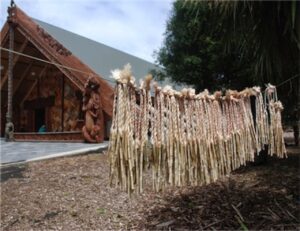
Te Noho Kotahitanga Marae 2011. Unitec, Tāmaki Makaurau/Auckland.
My practice draws on personal experience of traditional Māori weaving and the concept of mauri or life force embedded within these traditions. Informed by philosophical ideas contained within Māori weaving, alongside agential realism theories of feminist theorist Karen Barad, my work considers how I might manifest the life force of material through an installation practice.
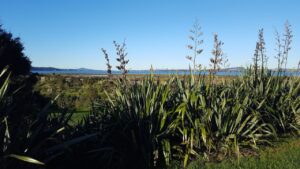
Te Atatū Peninsula 2019. Auckland/Tāmaki Makaurau. Harakeke (New Zealand Flax, Phormium tenax) in flower with kuruwaka (seed pods).
Working primarily with harakeke fibres, stone and found material, each work begins with gathering materials. Harvesting and processing leaf blades; scraping with a mussel shell to reveal silken muka (flax fibre); spinning on the bare leg to create thread; these durational processes are deeply significant to my practice. Attuned to the material’s inherent qualities, the relationship becomes one of responsibility to the material and the natural world.
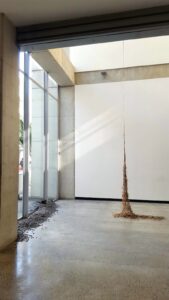
Michelle Mayn Harakeke Rope (installation) ongoing since 2019, hand-worked rope, suspended 35 metres in length from muka to harakeke mass, approximately 150 meters, pegged. Matariki Graduating Exhibition, St. Paul Street Gallery, Auckland, NZ.
In Māori weaving this focus, discipline and attention supports a state of being, where the weaver becomes receptive and open to the world around them, with the ability to act as a conduit between the metaphysical and physical world. My practice explores this relationship between the physical/material and non-physical/spiritual realm as a means of manifesting the life force, or mauri, of material.
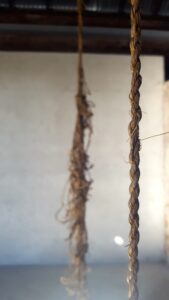
Michelle Mayn Harakeke Rope (installation) ongoing since 2019, hand-worked rope, suspended 35 metres in length from muka to harakeke mass, approximately 150 meters, pegged. Matariki Graduating Exhibition, St. Paul Street Gallery, Auckland, NZ.
Reverend Māori Marsden, a scholar and tohunga (expert, chosen one), defines mauri as the life force or life principle which “generates, regenerates and upholds creation”. For Marsden this is not an animistic notion, rather mauri is “inherent within all creation”, the “bonding element that holds the fabric of the universe together” (Royal, 2003).
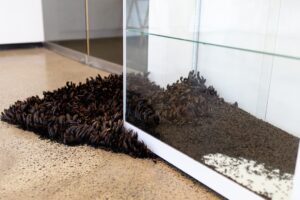
Michelle Mayn Kuruwaka (installation) 2019, sun-dried kuruwaka (harakeke seed capsules), harakeke seed extracted from kuruwaka, sifted and chaff removed, installed with the artist’s own breath, ongoing over 18 days, dimensions variable. Matariki Graduating Exhibition, St. Paul Street Gallery, Auckland, NZ. Photo: Steven Park.
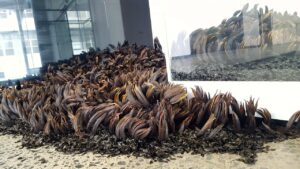
Michelle Mayn Kuruwaka (installation) 2019, sun-dried kuruwaka (harakeke seed capsules), harakeke seed extracted from kuruwaka, sifted and chaff removed, installed with the artist’s own breath, ongoing over 18 days, dimensions variable. Matariki Graduating Exhibition, St. Paul Street Gallery, Auckland, NZ.
Alongside this philosophical thinking I have considered Karen Barad’s theories, based on quantum physics. Barad also support the ‘aliveness’ of material where matter is not a “thing, but a doing, a congealing of agency…a materialisation of phenomena”. As such the world is composed “not (of) independent objects with innate boundaries and properties but rather phenomena”. This places humans entangled with material/matter at a quantum level. These entanglements, Barad argues, do not equate to interconnectedness (which implies individual entities), humans are “of the universe – there is no inside, no outside” (Barad, 2007).
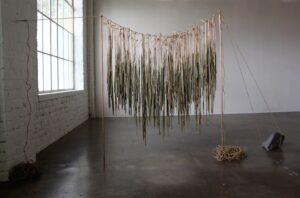
Michelle Mayn Pokinikini (installation) 2020, pokinkini (cylindrical, dried harakeke strands made from harakeke fibre partly extracted from the leaf blade by scraping with mussel shell), harakeke, basalt rock, Swarovski crystal, copper wire, copper rod, wax medium, metallic wax finish, 64” x 98.5” x 10”.
From this position, Barad suggests, knowledge arises through a focus on relationships among ‘things’ both human and non-human intra-acting within the world, as opposed to the notion of inter-acting separate entities. This perspective brings us close to Māori worldview where the physical world is not separate from the world that lies beyond our senses. The universe “comprised of a series of interconnected realms…unified and bound together” by a life spirit, can be understood as process (Royal, 2003).
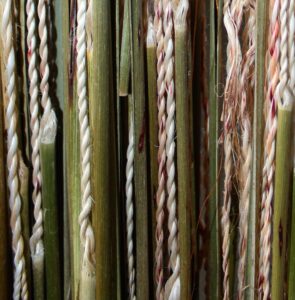
Michelle Mayn Pokinikini (installation detail) 2020, pokinkini (cylindrical, dried harakeke strands made from harakeke fibre partly extracted from the leaf blade by scraping with mussel shell), harakeke, basalt rock, Swarovski crystal, copper wire, copper rod, wax medium, metallic wax finish, 64” x 98.5” x 10”.
Being open to the idea of a world beyond my sense perception is a tangible thread that runs through my practice, one that becomes evident through a process-based practice like weaving. Material holds the physical trace of its environment, while durational processes and accumulated actions lead to a sense of the work’s self-formation. As maker, material is experienced not as inert and passive, but playing an intrinsic part in the work’s formation by its essential nature.
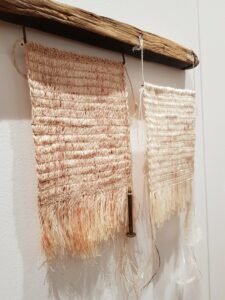
Michelle Mayn Two Tauira – Hokianga 2017-2019, muka (New Zealand flax fibre), driftwood from Hudson River (NYC), White Heron feather found in Kohukohu (Hokianga, NZ), bolt, metal pins, tacks and copper rod, 16.25” x 18.5”. Photo: Judith Hoek.
The idea of intra-actions between agents, humans and materials creating specific phenomena is a method I apply within my practice. Installations utilise air, wind, water, light, gravity, tension and other unseen forces to activate material so they appear to be acting from a sense of autonomous agency, thereby bringing the material to life. Materiality, in this context, activated by the forces surrounding it, can be newly understood as dynamic and vibrant, enriched and enlivened by us and by the world around us.
References
- Barad, Karen. Meeting the Universe Halfway: Quantum Physics and the Entanglements of Matter and Meaning. Durham: Duke University Press, 2007.
- Marsden, Māori. The Woven Universe: Selected Writings of Reverend Māori Marsden. Edited by Charles Royal. Masterton: Estate of Reverend Māori Marsden, 2003.
Link to Thesis
For a more in-depth look into these ideas a digital copy of my Masters thesis ‘Beyond the World of Sense Perception: Manifesting the Life Force of Materials Through Principles That Guide Actions’ can be downloaded from the University of Auckland’s digital repository Tuwhera.
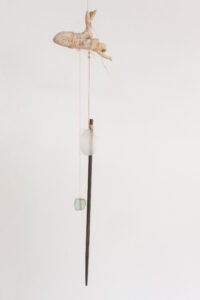
Michelle Mayn Wind Chime 2017, muka (NZ Flax fibre), metal file, weathered beach glass, feather, found bone, Swarovski crystal, 13.5” x 4”. Photo: Reece Evans.



3 Comments
Maggie Weiss says
January 15, 2021 at 8:38 am
Beautiful work; feels profound and meaningful and is compelling and striking to observe. Would love to see it in person some day.
CF-Peggy Wiedemann says
January 15, 2021 at 11:19 am
LOVE LOVE LOVE this work. So inspirational.
Bobbie Edelson says
January 18, 2021 at 12:51 pm
the exhibits are very unique and exciting. Such wonderful use of the unusual material.
Related Blog Articles
aotearoa
SDA Book Club: “Crafting Aotearoa” by D Wood
aotearoa
Member Spotlight: Jeanette Verster
aotearoa
Artist Spotlight: Imogen Zino